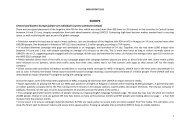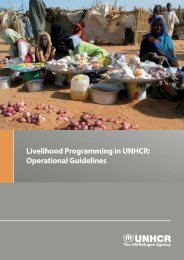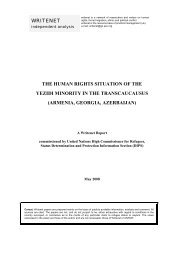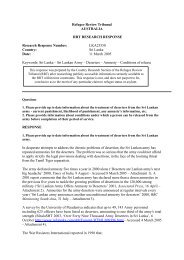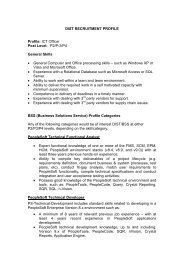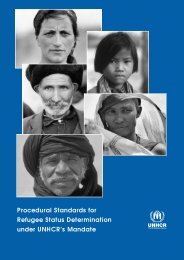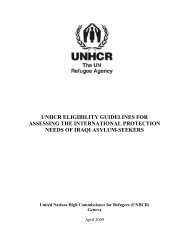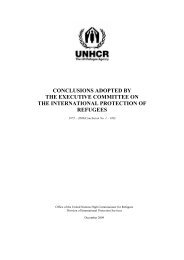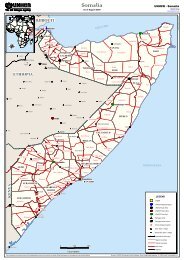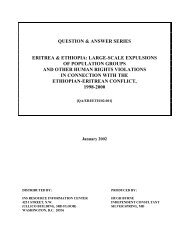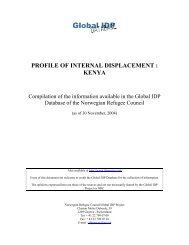UNHCR's ELIGIBILITY GUIDELINES FOR ASSESSING THE ...
UNHCR's ELIGIBILITY GUIDELINES FOR ASSESSING THE ...
UNHCR's ELIGIBILITY GUIDELINES FOR ASSESSING THE ...
You also want an ePaper? Increase the reach of your titles
YUMPU automatically turns print PDFs into web optimized ePapers that Google loves.
Two rival Shi’ite militias 111 have been blamed for much of the violence. The Badr<br />
Organization, formerly known as the Badr Brigade and SCIRI’s armed wing, is a powerful<br />
party that once took refuge in Iran from oppression by Saddam Hussein’s regime. 112 The<br />
Mehdi Army, which has on several occasions clashed with the MNF, was formed in 2003<br />
by the radical cleric Muqtada Al-Sadr. 113 Some reports suggest that parts of the Mehdi<br />
Army are no longer under the control of Muqtada Al-Sadr and act independently under the<br />
command of other individuals, e.g. Abu Diri, who became known for killing Sunnis. 114<br />
According to the US Department of State, the Mehdi Army “has replaced al-Qaeda in Iraq<br />
as the most dangerous accelerant of potentially self-sustaining sectarian violence in<br />
Iraq”. 115<br />
Since the Shi’ites came to power in the January 2005 elections, and in particular under the<br />
term of SCIRI Minister of Interior Bayan Jabr, 116 Shi’ite militia members entered the ISF in<br />
large numbers. 117 The Mehdi Army has built a strong presence in the regular Police and in<br />
the 150,000-strong Facilities Protection Service (FPS), 118 while the Badr Brigade<br />
111<br />
In several incidents, the Badr Organization and the Mehdi Army have engaged in battles over power and<br />
influence among Iraq’s Shi’ites. For example, after the killing of a local head of intelligence in Al-Amarah,<br />
a member of the Badr Brigade, his family kidnapped a local Mehdi Army chief in October 2006. This incident<br />
triggered a cycle of violent reprisals between the two parties, leaving some 25 people dead and several dozens<br />
wounded; see AP, Relative quiet returns to Iraq’s south; concerns linger over emboldened militias, 21<br />
October 2006, http://www.usatoday.com/news/world/iraq/2006-10-20-shia-militias_x.htm; John Ward<br />
Anderson, Sadr Militia Briefly Seizes Southern City, The Washington Post, 21 October 2006,<br />
http://www.washingtonpost.com/wp-dyn/content/article/2006/10/20/AR2006102000244_pf.html. See also:<br />
ICG, After Baker-Hamilton: What To Do in Iraq?, Middle East Report No. 60, 19 December 2006, p. 9-10,<br />
http://www.crisisgroup.org/library/documents/middle_east___north_africa/60_after_baker_hamilton___what<br />
_to_do_in_iraq.pdf; Reuters Alertnet, Battle highlights splits in Iraq’s Shi’ite south, 29 August 2006,<br />
http://www.uruknet.info/?p=26222.<br />
112<br />
For more information on the Badr Organization, see UNHCR, 2005 Country of Origin Information Iraq,<br />
p. 61-62, see above footnote 53.<br />
113<br />
For more information on the Mehdi Army and the armed confrontations with the MNF in 2004, see<br />
UNHCR, 2005 Country of Origin Information Iraq, p. 62-64 and 89, see above footnote 53.<br />
114<br />
Scott Johnson, Iraq: A New Enemy Emerges – “The Shi’ite Zarqawi”, Newsweek, 13 November 2006,<br />
http://www.msnbc.msn.com/id/15564792/site/newsweek/; Sudarsan Raghavan, Militias Splintering Into<br />
Radicalized Cells, The Washington Post, 19 October 2006, http://www.washingtonpost.com/wpdyn/content/article/2006/10/18/AR2006101801865_pf.html;<br />
Sabrina Tavernise, Cleric Said to Lose Reins<br />
Over Part of Iraqi Militia, The New York Times, 28 September 2006,<br />
http://www.nytimes.com/2006/09/28/world/middleeast/28sadr.html.<br />
115<br />
US Department of Defense, p. 19, see above footnote 73.<br />
116<br />
Bayan Jabr became Finance Minister in the Government of Prime Minister Al-Maliki where he continues<br />
to control the Interior Ministry’s budget and police salaries; see: Perito, see above footnote 109.<br />
117<br />
See, for example, Perito, see above footnote 109; Filkins, see above footnote 103; RFE/RL, Charles<br />
Recknagel, Iraq: Sectarian Violence Highlights Increasing Power Of Militias, 22 March 2006,<br />
http://www.rferl.org/featuresarticle/2006/03/3f8ef645-5fec-497d-8502-99a72fc4c9d8.html.<br />
118<br />
The FPS was formed by the former CPA, and is charged with guarding government buildings and<br />
infrastructure, including hospitals, ports and power plants. See: CPA Order No. 27, Establishment of the<br />
Facilities Protection Service, 4 September 2003, available in UNHCR’s Refworld at http://www.unhcr.org/<br />
cgi-bin/texis/vtx/refworld/rwmain?docid=469cda862. There is no unified command and the various FPS units<br />
stand under the control of the respective ministers. FPS officers were issued police-style uniforms, badges and<br />
weapons, but did not receive police training nor were they given police authority. Loyalists to Muqtada Al-<br />
Sadr control the ministries of health, transportation and agriculture and, according to the Iraq Study Group,<br />
FPS units employed by those ministries are “a source of funding and jobs for the Mahdi Army”. Iraq’s<br />
Minister of Interior, Jawad Al-Bolani, accused the FPS of running death squads, but rejected the notion that<br />
41




